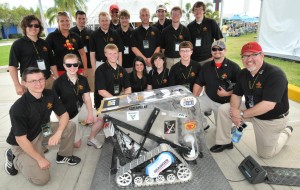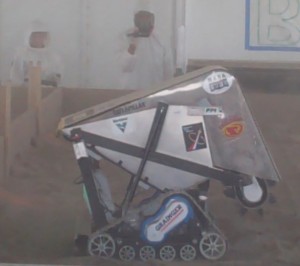After leaving NASA’s annual Lunabotics Mining Competition empty handed the past two years, Iowa State team members were determined to stand out at this year’s contest. Armed with a new design, Team LunaCY did that and more, earning first place in the categories of on-site mining, outreach, and communications with their robot, ART-E III.

Members of the club traveled to Cape Canaveral, Florida in May, competing against students from 58 other universities to see which teams’ robot could mine the most moon soil, or regolith, during a 10-minute time period. ART-E III was able to well surpass the competition’s collection requirement of 10 kilograms of regolith, successfully collecting 39 kilograms during the first round and ensuring the team a spot in the final round.
LunaCY continued to perform well in the finals, with ART-E III collecting 80.8 kilograms of regolith and earning the team its first of three top scores.
“During our second run, one of the engineers from NASA told us there are two kinds of robots−one that takes charge of the material and one that gets decimated by it,” said Ben McNeil, recent mechanical engineering graduate and project director for the club. “He said our robot was one of the very few he’d seen that could really take charge. Receiving that complement from him was incredible for us.”
Overall, the team earned an estimated 100 points, a score that factors in all the competition’s individual categories. The total was almost enough to surpass the University of Alabama, which earned approximately 109 points and came away with the grand prize, the Joe Kosmo Award. Final scores for all participating teams will be posted on NASA’s website.
While LunaCY did not receive the top prize, the team won the Communication Efficiency Award as well as the Outreach Project Award−a well-deserved recognition of the club’s 200 hours of outreach promoting STEM programs that reached more than 3,000 children.
“We assisted at about 20 different outreach programs this year including science camps and the FIRST LEGO League,” said Ryan McCleish, senior in mechanical engineering and club president. “We had a number of members step up to help out and we had just as much fun playing with the different technologies as the kids did.”
Adding to the team’s excitement during the competition, WALL-E, a robot created by the Iowa State robotics club, also made the trip to Florida. Operated by Aren Hill, senior in mechanical engineering and a member of both the Lunabotics and robotics clubs, WALL-E entertained crowds while also giving club members the opportunity to mingle with the public and discuss engineering.

Members also enjoyed interacting with other teams and learning from other students’ strategies. “One of my favorite things about the competition is how open the teams are with one another,” said McCleish. “We spoke with many of them and asked about different decisions they made and their reasoning behind those choices. It was helpful to be able to learn from others and also describe our own tactics.”
The team says developing new approaches and ideas is always important, which is why the first two years of participation in the competition were crucial to the team’s success this year.
“Our past experiences helped the students define what the design should be,” said Jim Heise, club advisor and mechanical engineering lecturer. “Several team members brought significant robotics knowledge to the club this year, and they spent a great deal of time working on the robot and teaching others.”
Though the competition only just ended, the team is certain that it will return to compete next year for the highest title. “They will review the design used this year and address any issues related to performance, durability, and suitability in space,” said Heise. “For next year, we suspect that ART-E IV will look somewhat similar to ART-E III, but there is a lot of time, work, and discussion to be had about that between now and next May.”
There is no doubt members of LunaCY have gained much from their time at NASA, yet McNeil notes the greater importance of these experiences.
“Lunabotics has given me the opportunity to take what I’ve learned in my classes and apply it,” he said. “I would like to eventually become a manager, and it’s allowed me to delegate to others and sort of set into that role.”
“All of the engineering clubs are excellent opportunities to build the skills that we’ll all eventually need.”
Members of the team encourage anyone interested in lunabotics to track the clubs progress for next year on the teams’ website and Facebook page.
Videos of the team at the competition can be found at the following links:
- WALL-E Interview: http://youtu.be/QOhLqNTSG1Y
- First pre-run interview with advisor: http://youtu.be/4WxhId1Mes8
- ISU Lunabotics First run part 1 of 2: http://youtu.be/wuqJ_OR8qZI
- ISU Lunabotics First run part 2 of 2: http://youtu.be/fZWrBW4gD0Y
- ISU Lunabotics interview post run: http://youtu.be/qNkK17tBtVY
- First Round ISU score: http://youtu.be/hce5FwuxBWo
- Second pre-run interview with advisor: http://www.youtube.com/watch?v=5cAxgXS0_ok
- ISU Lunabotics second run part 1 of 2: http://www.youtube.com/watch?v=ptlXOW4YJXU
- ISU Lunabotics second run part 2 of 2: http://www.youtube.com/watch?v=5AVzAXIGHi8
